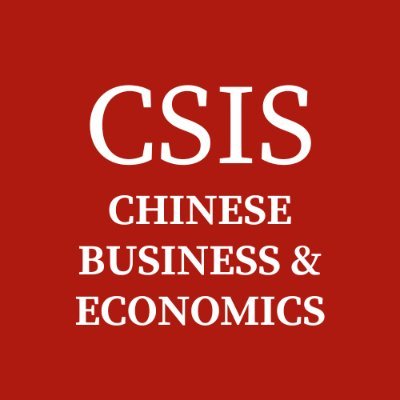
Ryan Featherston
@Ryanfeath
Followers
468
Following
39K
Media
88
Statuses
1K
Research Associate at @CSISCBE Thoughts are my own
Washington, DC
Joined July 2013
(1/10) Excited to share a new blog post on the wave of trade in programs in China and what they tell us about Beijing's efforts to boost consumption. https://t.co/EgeBsJrAoO Long thread for those interested!
csis.org
Ryan Featherston explains how China’s recent trade-in programs demonstrate the Chinese government’s thinking about the need for increased consumption. However, the “Two News” and their focus on both...
1
4
11
The Rise and Fall of LGFVs: update Apparently, following a nationwide audit in 2023, the central government (NFRA? MOF? who knows) updated its list of LGFVs, and it ballooned to nearly 18,000. That’s according to Caixin; I haven’t seen any official confirmation, let alone the
caixinglobal.com
Facing a 2027 deadline, some local government financing vehicles are just dressing up and still struggling to secure fresh funding
0
13
33
As a trade lawyer, settling in to listen to SCOTUS hear the IEEPA tariff case this morning feels like getting ready to watch one of the greatest superbowls ever.
17
14
220
TIL China's urban workers truly have the best pension scheme in the world: retire at 60 (55 for female), net replacement rates (pension/pre-retire earnings) at 88% (70.1%) while OECD retire at 66 on average at 61% replacement rate. Yet they still save 1/3 of disposable income.
15
74
352
Happy to share that @Ryanfeath and I are now on video too! Watch us talk about *CHARTS*! And more specifically Chinese EV-related exports and investments in emerging markets. Stay tuned for more! https://t.co/Sm7n0p6cat
1
5
12
We all know China is exporting EVs globally 🚗🔋🌏 — but where are they going, and what’s their impact on emerging markets? @Ryanfeath and I spent the past year digging into the data, policies, and experts across emerging markets to find out. (1/3) 👇
2
5
13
Interesting that involution discussion is in the unified national market section. Suggests an acknowledgment that local gov competition and industrial policy is a main factor?
0
0
2
On investment (the other side of domestic demand) an interesting mention that more government investment should be “livelihood-related” curious what that could include
1
0
2
Most concrete thing on consumption so far in the 15th FYP recommendations: “reasonably increase public services expenditure’s share of total expenditures”. Seems pretty modest, was looking at local gov budgets and usually is already one of their largest expenditures.
1
0
2
This is Charges for the use of intellectual property, receipts (BoP, current US$) https://t.co/WvzCoTQVWW
0
0
1
A bit confused by this, I get that it's scaled to services exports but similar data from IMF shows that while low, China receives similar levels of payments to South Korea. Not particularly impressive, but certainly not disastrous either?
1
1
3
Science PhD admissions at Harvard decreased by 75 percent. If Harvard science PhDs declined by 3/4, what does that mean for other universities? US S&T competitiveness rests on the university system. An own goal that will have lasting implications for US-PRC S&T competition...
🚨Breaking: @Harvard just announced massive cuts to dozens of its PhD programs, citing “financial pressure.” - Science PhD admissions reduced by more than 75% - Arts & Humanities reduced by about 60% - Social Sciences by 50–70% - History by 60% - Biology by 75% - The German
0
1
22
China has been trying to curb steel overcapacity for over a decade. For years, China tried "capacity replacement“ 产能置换 where new steel plants replaced outdated, inefficient ones, but capacity continued to rise. Now China is racing to cut output as domestic demand craters.
11
40
298
Been doing some textual analysis of Qiushi articles that I scraped, definitely more discussion of consumption/domestic demand this year, even a bit of an uptick in some older terms like domestic circulation, though common prosperity is clearly past its prime.
0
0
1
The biggest surprise in the recent NBS data release is the decline in China's manufacturing and infrastructure investment. The manufacturing surge could be ending due to the anti-involution campaign.
5
37
148
Come work with me next semester!
NOW HIRING: The Trustee Chair is looking for two part-time research interns to support our research on China's political economy and industrial policy for the fall semester. Submit your resume, cover letter, writing sample, academic transcript, and a list of 3 references in one
0
1
6
For some more of my musings on this topic and the political economy of a greater focus on internal demand check out my previous blog on the trade in programs from March:
csis.org
Ryan Featherston explains how China’s recent trade-in programs demonstrate the Chinese government’s thinking about the need for increased consumption. However, the “Two News” and their focus on both...
0
0
1
For they discuss looser monetary policy, fiscal reform so that local governments receive more revenue directly from consumption taxes, national market reform to eliminate local protectionism, and some consumer support (like trade in programs).
1
0
1
4: That creates cutthroat competition. "Oversupply has led some industries to fall into 'involutionary' competition, which not only increases the survival pressure of enterprises, but also in turn affects residents' consumption expectations and corporate investment intentions."
1
0
0
3: They acknowledge the government is responsible for part of the problem, often due to policy commitments. "For example, some local governments focus on production and neglect consumption, which often makes consumption growth unable to keep up with supply expansion. "
1
0
0
2: There is a reckoning with weak consumer spending; "World Bank data shows that in 2023, global consumer spending accounted for an average of 56.5% of GDP, including 58.7% in high-income countries, 52% in middle-income countries, and only 39.6% in our country."
1
0
0












